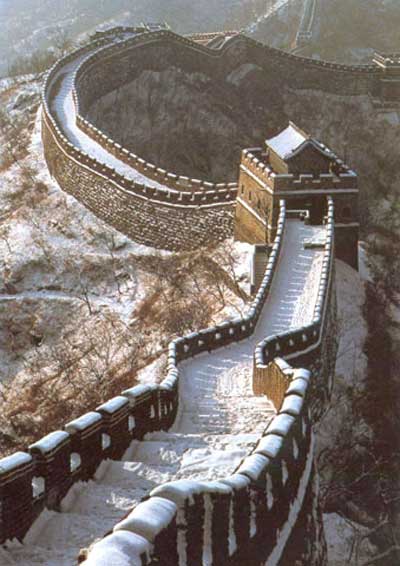The Great Wall: a defensive structure you can view from space?

Of course you can't. Think about it for a moment; it's long, but what difference does that make? It's not that wide or tall at any point. This is an old, old myth, popularized by Ripley's Believe it or Not, but it received tacit support from the state in the 1960s, when China wasn't even at the starting line in the US-USSR Space Race. "Who cares if we're not on the moon?" the subtext went, "Look at what we were doing when you were still scrabbling in the mud!"
But where to begin when it comes to Great Wall myths? For starters, the very concept of a single unified "Great Wall" is a misleading one, a creation of European travelers and later, Chinese nationalism. In reality, the Wall is a collection of separate fortifications, collectively best labeled "the Long Walls," built by different dynasties for different purposes.
Like most fortified positions, its intentions were as much aggressive as defensive. Until relatively recently, Chinese foreign policy was orientated mostly towards the north, where a vigorous series of invaders and empires rose to challenge, and sometimes conquer, the Chinese state in its various incarnations.
The Long Walls as often served as jumping-off points for Chinese military expeditions as they did as defensive positions against nomadic raiders. On top of that, the Walls were often built around lands very recently settled by Han colonists; like colonial fortresses in the Americas, their purpose was to keep out the people whose lands had just been nicked.
Much of the time, though, the Walls' most frequent function was to serve as a customs barrier. Northern trade was huge business, from tea to furs to horses. Hadrian's Wall served a similar purpose in Britain, as did the "Great Hedge of India," a two-thousand-mile-long mass of trees, brambles, and thorns planted by the British right across the country to enforce the notorious Salt Tax.
The Walls themselves fell into disrepair for years, after the Qing conquest made them redundant. They were revived mostly through European admiration, which then filtered back into Chinese nationalist consciousness to create an idea of "the Great Wall" as a symbol of a unified nation – and to produce T-shirt slogans for tourists.
 0
0 








Go to Forum >>0 Comments